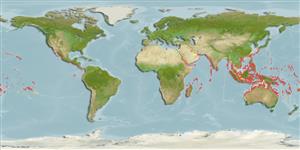Environment: milieu / climate zone / depth range / distribution range
นิเวศวิทยา
เกี่ยวกับทะเล,น้ำเค็ม เกี่ยวกับหินโสโครก; ระดับความลึก 2 - 30 m (Ref. 30874). Tropical; 32°N - 32°S
Indo-Pacific: East Africa to the Tuamoto Islands, north to southern Japan, south to New South Wales and Tonga.
ขนาด / น้ำหนัก / Age
Maturity: Lm ? range ? - ? cm
Max length : 24.0 cm TL เพศผู้/กระเทย; (Ref. 5372)
เงี่ยงครีบหลัง (รวม): 12; ก้านครีบอ่อนที่หาง (รวม): 24-27; เงี่ยงครีบก้น 3; ก้านครีบอ่อนที่ก้น: 17 - 19.
Occur in lagoon and seaward reefs with rich coral growth. Juveniles solitary; adults are often paired and occasionally found hovering side by side under tabular corals (Ref. 1602). Feed on bottom living animals (Ref. 6113), e.g. invertebrates associated with algal zones (Ref. 5503). Oviparous (Ref. 205). Form pairs during breeding (Ref. 205). Minimum depth reported taken from Ref. 30874.
Life cycle and mating behavior
วัยเจริญพันธุ์ | การสืบพันธุ์ | การวางไข่ | เซลสืบพันธ์ของเพศเมีย(ไข่) | ความดกของไข่ | ตัวอ่อน
Form pairs during breeding (Ref. 205).
Steene, R.C., 1978. Butterfly and angelfishes of the world. A.H. & A.W. Reed Pty Ltd., Australia. vol. 1. 144 p. (Ref. 4859)
IUCN Red List Status (Ref. 130435)
Threat to humans
Harmless
Human uses
สถานที่แสดงสัตว์และพืชน้ำ: การค้า
ข้อมูลเพิ่มเติม
ชื่อสามัญชื่อพ้องกลไกการเผาผลาญพลังงานผู้ล่าการศึกษาเกี่ยวกับผลกระทบของสารประกอบทางเคมีที่เป็นอันตรายต่อสิ่งมีชีวิต ประชากร และสิ่งแวดล้อมการสืบพันธุ์วัยเจริญพันธุ์การวางไข่การรวมกลุ่มวางไข่ความดกของไข่เซลสืบพันธ์ของเพศเมีย(ไข่)Egg development
อ้างอิงการเพาะเลี้ยงสัตว์น้ำประวัติการเพาะเลี้ยงสัตว์น้ำสายพันธุ์พันธุศาสตร์ElectrophoresesอัตราพันธุกรรมโรคการแปรรูปNutrientsMass conversion
เครื่องมือ
Special reports
Download XML
แหล่งที่มาจากอินเตอร์เน็ต
Estimates based on models
Preferred temperature (Ref.
123201): 24.7 - 29.3, mean 28.3 °C (based on 3917 cells).
Phylogenetic diversity index (Ref.
82804): PD
50 = 0.5039 [Uniqueness, from 0.5 = low to 2.0 = high].
Bayesian length-weight: a=0.02042 (0.01294 - 0.03221), b=3.05 (2.92 - 3.18), in cm total length, based on LWR estimates for this species & (Sub)family-body (Ref.
93245).
ระดับชั้นอาหาร (Ref.
69278): 3.5 ±0.37 se; based on food items.
ความสามารถในการกลับคืนสู่ปกติ (Ref.
120179): ความสูง, เวลาต่ำสุดที่จะทำให้ประชากรเพิ่มขึ้นเป็น 2 เท่าใช้เวลาน้อยกว่า 15 เดือน (Preliminary K or Fecundity.).
Fishing Vulnerability (Ref.
59153): Low vulnerability (14 of 100).
Nutrients (Ref.
124155): Calcium = 76.1 [39.9, 118.8] mg/100g; Iron = 0.703 [0.422, 1.121] mg/100g; Protein = 18.8 [17.7, 19.9] %; Omega3 = 0.114 [0.072, 0.177] g/100g; Selenium = 30.7 [18.0, 56.9] μg/100g; VitaminA = 49.8 [15.1, 158.1] μg/100g; Zinc = 1.18 [0.81, 1.68] mg/100g (wet weight);
